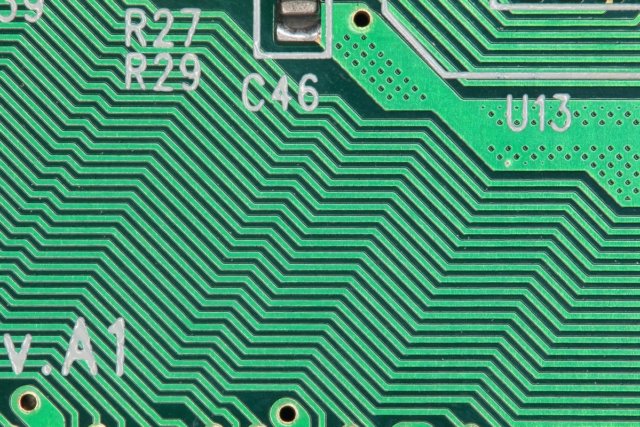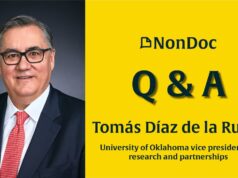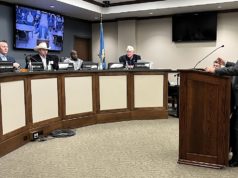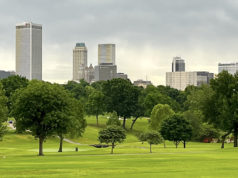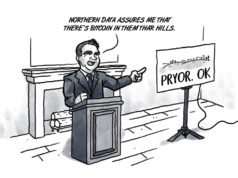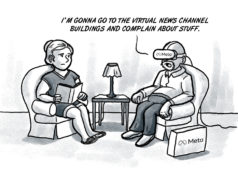Although the networking of digital sensors may not sound like a compelling issue, we are rapidly entering the world of the Internet of Things, or IoT. The old-fashioned assembly line approach to mass production is collapsing.
Data and 3-D printing is turning our economy into maker spaces. As the 21st century progresses, individuals will be able to design and create their own products.
These trends were among the topics discussed at the Oklahoma University Health Science Center and OKC Innovation Zone’s Sensors Symposium June 11 at Embassy Suites/Downtown Medical Center. Also discussed: How Oklahoma could become a new Silicon Prairie.
Mixing the digital world with reality
Dave King, founder/CEO of data- and software-development firm Exaptive, kicked off the event with a conversation with Ben Campbell, co-founder and CEO of augmented reality group Overworld. Augmented reality (AR) is basically a cousin to virtual reality (VR). The difference is that VR is fully digital, while AR places digital objects in the real world. For instance, AR can turn CT scans into 3-D products. AR also allows innovators to add longevity to systems, optimize digital platforms, intervene in trouble spots and create remote-sensing systems. This is possible because AR allows developers to visualize digital content within their own 3-D world and add information to physical items, in turn narrowing the gap between our physical and digital realities.
A new kind of rush
As was later explained by Greg Hall of WellCaddie, which develops oil and gas-monitoring solutions, we are well into the Data Rush — the 21st-century version of the Gold Rush. In this rapidly emerging, data-driven IoT world, manufacturing jobs and many professional positions are disappearing as diverse data networks promote production of all sorts of goods by entrepreneurs. A successful transition to the Internet of Things requires the type of interdisciplinary discussions that the conference inspired.
Creating systems with longevity in mind
The need to improve networks’ longevity was first explained by experts from the Oklahoma City Air Logistics Complex at Tinker Air Force base. Today’s military and civilian technical systems must now remain in place for far longer than anticipated. As it was subsequently noted, the 1861 Drake oil well is still producing, and most oil wells are lasting two to three times longer than expected. We have been flying B-52 bombers since 1952. To keep these systems operating, technological responses must be “organized and agile.” Old networks must undergo reverse engineering and be updated by “organic innovation.”
Discussions about optimization of platforms then provided concrete examples of “future creep,” where engineers start by worshiping the “art of the possible” and risk making systems too complicated. Meanwhile, some of the most valuable innovations are easily understandable, with obvious benefits. For instance, we’ve invested huge amounts of money and research into trucks while overlooking the benefits of sensor systems for the rigs that they pull. Tire blowouts are just one danger of the unimproved trailers that are pulled across our highways. Digital systems can provide real-time warning of air leaks and even add more air to tires while driving.
Other remote-sensing systems use drones to improve severe weather forecasting. Remote sensors can also improve agricultural productivity while conserving water and using fertilizers in a more efficient manner. Dr. Micheal Businelle, Director of the Stephenson Cancer Center, described medical sensors that can help treat alcohol and drug abuse while ensuring medications are taken as prescribed. For instance, a sensor in a pill bottle lid can warn a person who has forgotten to take their meds.
Sounds good. What does it mean, though?
As the presentations moved deeper into medical interventions, much of the discussion went even farther over my head, but some of the best aspects of the symposium became obvious. Dr. Nesreen Alsbou’s presentation on her “6D Mobile Deformable Thorax Phantom” stimulated wonderful exchanges about remote monitoring of medical conditions. And although Dr. Binbin Weng’s “Mid-Infrared Photonic Technologies” was even more difficult for me to grasp, I loved listening to advanced researchers exchanging possible research strategies. Especially interesting were discussions of digital security and research methodology.
‘Data isn’t knowledge, and knowledge isn’t wisdom’
The discussions that were most valuable for me were instigated by Greg Hall’s quotable presentation. He had graduated in the top 10 of his class (of nine students) back when a slide rule was a state-of-the-art calculator. Hall warned, “Data isn’t knowledge, and knowledge isn’t wisdom.”
Speaking with the bluntness of an old-school independent oilman, Hall explained that innovations that seem wonderful in the office often don’t play well in the field. He called for a cultural revolution: Unless trust is built, workers are likely to make sure that digital systems don’t work. The oilman thus prompted a conversation about compliance and noncompliance in “future-proof” systems.
Other takeaways
As we celebrate amazing 21st-century medical technologies, we can’t forget that few innovations can improve outcomes as much as simple things like hand washing. Steve Montgomery, CEO and founder of Digital Six Laboratories, offered frightening data on noncompliance with hand-washing rules as well as using technology to “nudge” people toward healthier practices. Dr. Melchor Antuñano, Director of the Civil Aerospace Medical Institute at the FAA’s Office of Aerospace Medicine, provided lessons on successful methods for building buy-in. If data is used to hold individuals accountable for the performance, pushback is inevitable. If sensors document behaviors that promote health and safety, however, successful conversations can result.
We need innovators in our schools
These conversations must spread through our economy, and they are especially crucial for our education systems. We’ve turned our schools into sped-up Model T assembly lines, but kids need creativity, experimentation and STEAM instruction (science, technology, engineering, art and math). As wonderful as it is for the OUHSC and the Innovation Zone to create an environment for interdisciplinary discussions, those conversations must also become intergenerational. To improve our public schools, we must build partnerships between these innovators and our schools. Unless I miss my guess, the participants in the Sensors Symposium would love participating in project-based learning and sharing insights about IoT with neighborhood school students.








